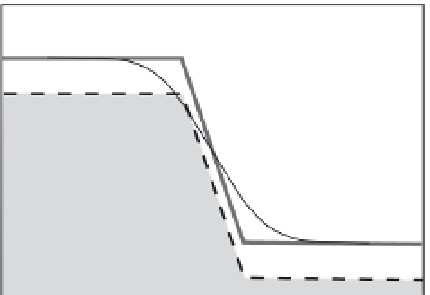Geology Reference
In-Depth Information
on height of the scarp, tall scarps having higher
effective diffusion coefficients, and Pierce and
Colman (1986) attribute this greater diffusivity
to the operation of slopewash processes that
are dependent on slope length - in other words,
the equation describing hillslope discharge is
no longer simply dependent on slope, but is
dependent on position on the slope,
x
.
8
Scarp Evolution with Weathering
10
initial
4
note symmetry
of curvature
50
20
sediment
0
final
bedrock
-4
sediment
on bedrock
Weathering-limited situations
A
In landforms that are not entirely composed of
loose, transportable materials, one must take into
account the transformation of the cohesive mate-
rial (or bedrock) into material capable of being
transported by the available surface processes.
This requirement was recognized early by Gilbert
(1909), in his classic word picture of how convex
hilltops operate. More recently, Anderson and
Humphrey (1989) have modeled the evolution of
scarps and moraines in the face of weathering and
linear diffusion. In such cases, one must posit a
second rule that represents this transformation of
rock into transportable material - call it the weath-
ering rate,
W
. Anderson and Humphrey (1989) fol-
lowed the proposal of Ahnert (1970), who was
following Gilbert's (1877) word picture, in which
the rate of transformation depends solely on the
thickness of the regolith (defined as the layer
of transportable material). Although other rules
could be entertained, Anderson and Humphrey
(1989) use a simple exponential, in which the
maximum rate of regolith production was achieved
on bare bedrock (no regolith) and decayed expo-
nentially with increasing regolith thickness:
8
note high
curvature
B
10
initial
4
50
20
0
final
bedrock
-4
bedrock
only
-8
0
20
40
60
80
Horizontal Distance (m)
Fig. 11.8
Illustration of the effects of weathering-
limited case on the evolution of scarp profiles.
Bedrock interface, early (thick dashed line) and at
termination of the simulation at 50 ka (thin dashed line);
and surface topography at 0 (initial), 10, 20, and 50 ka
(full lines). A. Pure diffusion case is allowed by dictating
that the initial bedrock interface be deeply buried, such
that the bedrock is only etched into late in the simula-
tion. B. Shallow initial bedrock interface (0.2 m) restricts
rate of rounding of the scarp crest, whereas surface
processes still effectively smear the growing colluvial
wedge. This shallow bedrock breaks the symmetry of
the pure diffusion case, the top of the scarp showing
consistently higher curvature than the base. Modified
after Anderson and Humphrey (1989).
∂
∂
z
−
RR
*
b
==−
WW
0
e
(11.10)
t
where
z
b
is the local elevation of the regolith-
bedrock interface,
R
is the regolith thickness,
W
0
is the rate of bare bedrock weathering, and
R
* is
a regolith thickness at which the rate of regolith
production is 1/e (or roughly 1/3) of that on bare
bedrock (recall that e is roughly 2.72). The rule
set must now include both the rate of lowering
of the bedrock interface and the rate of change
of the regolith due to surface processes, which
is controlled by the diffusion equation (see
Fig. 11.5). The relevant diffusion equation is now
∂
∂
2
R
z
=
k
(11.11)
2
∂
t
∂
x
and the surface elevation at any point in time is
z
=
z
b
+
R
. With these modifications, Anderson and
Humphrey (1989) show that the symmetry for a
scarp's crest and toe that one expects from pure
diffusion in the absence of weathering is broken
(Fig. 11.8). The base of the slope rounds as



































































